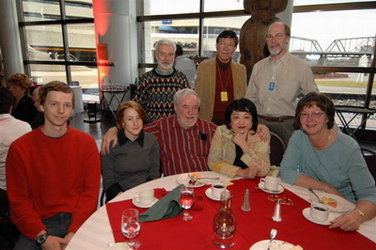Our Study Team:
Our research team is an informal group of varying size and membership within the Canadian Museum of Civilization Volunteers, 100 Laurier, Gatineau, Quebec, Canada. We come from all walks of life: undergraduate, graduate and postgraduate students in various academic programs, retirees, and those employed elsewhere. Our common goal is to make available to our viewers our current research in gendered spatial analysis for comment and educational purposes. Our project leader is Dr. Bryan Gordon, former Arctic Archaeologist and now a Curator Emeritus (Research) with the Museum. Our webmaster is Spencer Sutton.
Our Approach:
Our software designer, Raymond Cheng, has developed the analytical tool DSA (Dynamic Spatial Analysis), enabling us to query large databases of artifacts, and to output each query result as a scatterplot. By refining our search criteria, we can produce the distribution of any or all artifacts in each of many levels in nine stratified archaeological sites in the Beverly caribou range of the Northwest Territories and Saskatchewan. Four sites, KjNb-6,7, 9 and 13, are in close proximity to the largest water-crossing, used each July by the Beverly herd. KeNi-4, at the Thelon headwater’s Whitefish Lake, is the largest site, and was used from late spring to early winter by resident hunters, plus the nearby small but related KeNi-5. Joining the inhabitants of KeNi-4 and 5 in August are those hunters returning from the Thelon water-crossings and a basalt artifact trading group from KkLn-4 on Grant Lake and KdLw-1 on Mosquito Lake on the lower and middle Dubawnt River. We can set our search criteria for in-site and between-site comparison for any common cultural level so that we can compare seasonal activities of one or more particular groups. Using interlevel comparison we can compare seasonal activities over time in one or all sites. In conjunction with these 8 sites are 994 surface sites, some with plotted artifacts. Altogether, we can plot trade items moving through the Thelon and Dubawnt Basins in the form of copper, chert, basalt, silicious shale and exotic coloured quartzites such as red quartzite. Copper was likely carried all the way from the northwest from near the Coppermine Delta, while the source of the special Pre-Dorset chert is still undetermined, but probably also came from the northwest.
One of our major achievements has been deciphering palimpsests, the bane of archaeologists. A palimpsest is a scattering of artifacts from different times on the ground surface or a buried level. As its formation varies from minutes to centuries, we separate it into activity areas relating to the various stages of caribou harvesting and processing. We are very fortunate that the ancient hunters had many types and materials of artifacts of a vast range of colours to separate stone knapping activities. Ethnographic analogy allows to us to assess the gender of the people in specific activities. Generally, men knapped the tools, hunted, and worked with wood and bone, while women stripped and dried meat, removed and stored marrow and sewed. Both sexes shared the butchering of carcasses.
Ethnographic analogy allows to us to assess the gender of the people in specific activities. Generally, men knapped the tools, hunted, and worked with wood and bone, while women stripped and dried meat, removed and stored marrow and sewed. Both sexes shared the butchering of carcasses.
What we do:
We reconstruct the tasks done by ancient men and women by examining the distribution of the tools they dropped. As each task needs specific tools that are often gender-related, we examine their arrangement so we can place scaled bird’s eye views of male and female icons on each living floor. We orient these icons on the basis of tool scatter, handedness (left 20% or right 80%), wind direction where hearths are involved, and sequence if a task requires a series of steps. Comparing tool arrangements with those in floors used in different seasons, or those used by other cultures centuries apart, allows us to see if gendered tasks varied over time. Hunter-gatherer tasks typically do not involve differences in power and authority, so we look for tasks that you or I would do, given their circumstances. By counting the number of icons for each task for each floor, we can estimate their intensity by season and culture. Using this information we gain some idea of family size. Did boys assist their fathers or uncles in the hunt? Did girls help their mothers or aunts in preparing food or skins? Can we envision an assembly line operation? When did both genders work side by side?
Our Objectives:
We wish to discover how ancient Barrenland hunters lived. Their descendants still hunt the peripheries of the Beverly caribou range, so it is informative that we compare their behavior with that of their ancestors. By having over a thousand sites for study, plus the main database of the remaining Northwest Territories sites at the Canadian Museum of Civilization, we can also compare long distance trade. For example, one of our sites, KeNi-4 at treeline, has most copper objects. Using our surface and stratified sites, plus the Museum’s sites, we can plot trade routes from the Coppermine to our area. For project development, we try to place ourselves in the role of the hunter (the provider) or his wife (the processor). Examining gender-specific artifacts from Inuit and Indian ethnology, and knowing the limitations and opportunities imposed on us in our role, we write reports to give everyone insights into the logical choices made by ancient people.
